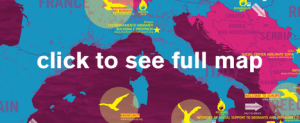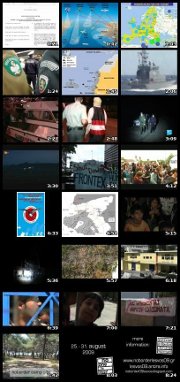About the Map of Resistance against the European border regime
In November 2012 an English-French poster called „Transborder Map“ appeared, first online at noborder.org, in the meanwhile also in a printed version. Against the background of a geographical map of Europe, it shows initiatives and projects (also presented in a few sentences on the back) which met at a conference in Istanbul in March 2012 and whose members are defying the migration regime on both sides of the EU’s external borders and beyond. Sixty activists from fourteen countries participated in the exchange meeting; the map is a product of this transnational network.
Whether at the Greek-Turkish Border and in the Aegean, in the straits of Sicily or Gibraltar, and around the island of Lampedusa or the enclaves of Ceuta and Melilla: the pictures made at the various focal points, the so-called hotspots of the external borders, resemble each other. Monstrous fences and high-tech surveillance systems, detention camps and permanent deployment of the border control agency Frontex, all funded by the EU, characterize the situation along the major neighbouring states. The Ukraine, Turkey, Libya, Tunisia, Morocco and even West African countries are, from the point of view of the EU, essential stations of transit migration and should – by means of economic pressure and financial incentives – as much as possible be forced to integrate with migration control. This externalisation strategy, the outward shifting of the border regime towards the south and the east, has resulted in distress and thousands of deaths being calculated in, in the context of a EU deterrence strategy against „illegal migration“.
Transnational campaigns and structures
What has evolved over these last years as a transnational resistance is therefore all the more important. Three examples: in 2009, with the Noborder camp on Lesbos, not only multiple contacts – in particular with the Afghan and East African migration communities – were established and, through the confrontation with Dublin II (1), maintained during further joint struggles. The camp also was a catalyst for monitoring and support projects along this – statistically considered (2) – most important migration route from Turkey, via Greece, in the direction of north-western Europe.
With the bus caravan for freedom of movement and just development from Bamako to Dakar in early 2011 (3) a further step was taken towards Euro-African cooperation. A continuous exchange has in particular been established with groups in Mali.
And with the Arab Spring new possibilities and necessities arose in the cooperation with organisations in North Africa. With the fall of the „watchdog regimes“ in Tunisia and Libya and in view of the rigid visa politics of the EU, increasing numbers of migrants again took boats in order to get to Europe via Lampedusa and Sicily. Many did and still do die in this way, more and more often also because border guards refuse to rescue them. Against this background a new project of Euro-African solidarity against the lethal border regime at sea, with an emphasis on Tunisia, was started in July 2012 with Boats4People.
If the Noborder camps, caravans and solidarity boats in the contested border areas stand for public actions, yet rather symbolic interventions, the contacts and collaborations have nevertheless evolved into longer-term structures which increasingly turn into effective networks. The knowledge acquired in this way undergoes multiple transformations, for instance into the virtual flight-assistance-guide of Welcome to Europe, which in real supports refugees and migrants on the move, offers useful addresses and practical information from all the important transit and target countries in four languages.
Tenacious movements of migration at all the external borders …
The lethal events in October 2005 in Ceuta and Melilla, the Spanish enclaves in Morocco, are in general considered a turning point: Spanish and Moroccan border policemen countered the collective storm of migrants on the fences with plastic bullets and even live ammunition. At least fourteen people died and hundreds were brought in the direction of the Algerian border in buses and left there in the desert. Despite massively increased controls and repressions towards transit migrants in Morocco and despite the insane armament of the fence systems in Ceuta and Melilla, this border remains a highly controversial centre of struggle to this day. Again and again individuals succeed in scaling the fences or swimming around them, and in August 2012 there were again several hundred who collectively tried to defeat the obstructions (4).
After 2008 and 2009 when the Aegean islands were the principal target of the migrants, the route changed drastically in 2010. The Greek-Turkish land-frontier along the Evros river now became the central place of transit. Even the deployment of Frontex and imprisonment as a deterrent at first could not stop the self-determined entries into the country. The crisis and the smaller chances of survival, the systematic raids of the police and the racist pogroms, as well as – finally – the mobilisation of thousands of border policemen at the border, shifted the picture again in the summer of 2012. There are less people arriving but now again by sea and on to the islands, also on to Lesbos. There, solidarity groups succeeded by the end of November in forcing through an open welcome centre for the new arrivals (5). Considering that in general closed centres and prisons are the reality in Greece, prison riots of the detained refugees and migrants regularly occur.
With the fall of dictator Ben Ali, numerous new actors emerged in Tunisian civilian society.
For the transnational network against the migration regime, the relatives of the missing and drowned Harragas (6) are important, who with their protests not only demand to be informed about the fate of their families and friends, but simultaneously demand the abolishment of the EU visa regime and criticize their own government for its collaboration with the EU. „We made this revolution for dignity and democracy,“ said the spokeswoman of a group of Tunisian mothers of missing persons in July 2012 at an international assembly. And also: „The government stands by doing nothing, our sons have made the revolution, but we still do not have results concerning their whereabouts. There will be a second revolution, if the situation does not change.“ When in September 2012 another boat capsized in close vicinity to Lampedusa and 79 Tunisian migrants – among them children – died, this resulted shortly afterwards in a local uprising in El Fahs, one of the cities of origin of the victims. Strikes were taking place and several police stations as well as the office of the governing party were set on fire.
… Refugee strikes and protests inside the EU
The continuous and tenacious struggles for freedom of movement at the external borders, at this moment correspond with a wave of strikes, protest camps and demonstrations of self-organized refugees inside the EU, e.g. in Germany, the Netherlands, Austria, Poland and Hungary (7). The respective basic conditions are as diverse as the composition and the demands of the actors. Direct connections are so far limited, but the mutual inspiration is obvious. Refugees‘ experiences of struggle during transit are often made part of the actions.
The – until now – static version of the Transborder Map only shows a few key-symbols for migrant struggles inside the EU and does make no claim to be exhaustive. The map nevertheless offers a first survey of an increasing number of networking initiatives all over Europe and beyond. And this initial impetus goes with the proposal to construct an interactive platform. That is a map, which is to be completed and kept up to date, which at the pulse of the movements of migration visualizes the diversity of the resistance and thus strengthens the struggles for global freedom of movement as a transnational process.
The Mapping Team from Hamburg and Hanau
Notes:
(1) EU Regulation on Asylum, stipulating that refugees must be kept in the EU country of their first registration;
(2) From time to time several hundred people per night, in 2010 totalling 47,000 and in 2011 even 55,000 registered „illegal“ border crossings;
(3)see: http://afrique-europe-interact.net
(5) see: http://lesvos.w2eu.net
(6) Arab word for migrants without a visa which in translation means „burner of borders“;
(7) see: http://www.refugeetentaction.net , http://wijzijnhier.org/nl , http://refugeecampvienna.noblogs.org



